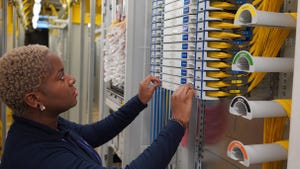Telstra Dumped From FTTx Project
Telstra's bid to build Australia's national broadband network has been thrown out by the government for failing to meet RFP specs
December 15, 2008

Australia's plan to deliver fixed broadband connections to its 21 million residents entered a controversial stage today when the government rejected a national broadband network (NBN) proposal from Telstra Corp. Ltd. (ASX: TLS; NZK: TLS) on a technicality related to its RFP (request for proposal) guidelines.
Telstra, which abandoned its original fiber-to-the-node (FTTN) plans in 2006 after knocking heads with Australia's regulators, submitted its fresh bid in late November, claiming to be the only company with a funded and viable plan to take next-generation broadband services to the vast majority (90 percent) of Australia's population. (See Telstra Proposes National BB Net and Telstra Abandons FTTN Plan.)
Today, however, Australia's Minister for Broadband Communications and the Digital Economy, Senator Stephen Conroy, issued a statement saying Telstra had been "excluded from any further consideration in the National Broadband Network (NBN) Request for Proposals (RFP) process" because it failed "to submit a Small and Medium Enterprise (SME) Participation Plan, which is one of five mandatory requirements of the RFP."
News that the government had kicked out Telstra's multibillion-dollar FTTN proposal, but accepted plans from five rival operators, knocked 11.6 percent off the national carrier's share price, which ended Monday at 3.65 Australian dollars.
The minister's statement noted that the "RFP was specifically designed to give proponents flexibility in preparing their proposals, and there are very few mandatory requirements," one of which was the submission of a plan "outlining opportunities for Australian and New Zealand SMEs to provide goods and services to the project.”
Conroy added: "There was nothing to stop Telstra from submitting a complete proposal and competing vigorously with other proponents in this process. Instead, the Telstra Board failed to comply with the mandatory requirements of the RFP... Industry was offered the chance to compete on a level playing field under the RFP. However, the Telstra Board sought special treatment by proposing its own process... Telstra had more than enough time and resources to fully understand what was required of proponents in this process."
And the minister didn't hold back in attempting to put Telstra in its place. "Telstra’s Board will have to explain to its shareholders why it has decided to sideline itself from a process that will shape the Australian communications sector for the next decade. The Government’s NBN process has always been bigger than Telstra."
Telstra hits back
Telstra's CEO, Sol Trujillo, who told Light Reading in June about his frustration with the slow pace of Australia's broadband plans, hit out at today's decision during a conference call with analysts and the media. (See Telstra CEO: Survival of the Bravest.)
Trujillo said the government made its decision "on the basis of a triviality that we did not include a small medium enterprise, or SME, participation plan as part of our proposal on 26 November. We did submit an SME plan in early December based on the way they drafted the RFP, and we think that they’re wrong in the way that they’ve reached their conclusion. In any event, had the minister wanted us to be included he had ample ability under the RFP to have us there."
The CEO reiterated his belief that Telstra's proposal is the only one that is financially viable: It involves a pledge of A$5 billion (US$3.3 billion) of capital from the carrier along with a A$4.7 billion (US$3.1 billion) loan from the government. The resulting network, which would be open on an equivalent access wholesale basis to all other service providers, would be capable of delivering downlink speeds of up to 50 Mbit/s to three quarters of the covered area, and up to 20 Mbit/s in the remaining 25 percent. That would be enough to support services such as IPTV, videoconferencing, and telemedicine, stated Telstra.
Telstra, which has already upgraded its fixed broadband access network to ADSL2+, will continue with its own broadband plans, but Trujillo noted that "it is open to the Government to re-engage with Telstra if and when it wishes... We remain hopeful that sense will prevail outside the RFP process at a later date. But if not, let me be clear, we have plenty of options and will continue to act in the interests of our shareholders, customers, and employees."
Trujillo wouldn't be drawn on whether he thought the decision was politically motivated: "We are a bit surprised at [the government] taking this action on a triviality, which we are very clear in our minds that we were fully compliant in the language in the RFP, in terms of how we handled this matter. So I don’t want to speculate beyond that, because I’ve not had any conversation with the minister or the appropriate people involved."
And Trujillo made it clear that he doesn't believe any of Telstra's rivals, which have already been on the receiving end of some specific accusations from Telstra, are capable of building the NBN. (See Telstra Slams Rivals.)
Most of the other companies with NBN proposals "don’t have major staffs, don’t have engineering capabilities that are of this order of magnitude, don’t have the trucks, don’t have the people, don’t have the training, don’t have many of the resources required just to get started. Then it’s another thing to get started and to build and obviously, even if Telstra were to do it, it’s a minimum five-year process... Then you actually have to be able to operate it, and what are the processes in order to do that? This is highly complex, will be highly contested, and will involve a very long period of time." (A full transcript of the conference call and Telstra's proposals for the NBN can be found at the operator's investor relations page.)
The five proposals that did meet the government's RFP requirements come from: Acacia Australia, which is headed by a former Telstra CEO, Doug Campbell; Axia NetMedia Corp. (TSE: AXX); Telstra's main competitor SingTel Optus Pty. Ltd. , which has teamed up with a consortium of ISPs known as TERRiA; alternative operator TransACT; and the Tasmanian government.
— Ray Le Maistre, International News Editor, Light Reading
You May Also Like



.jpg?width=300&auto=webp&quality=80&disable=upscale)






